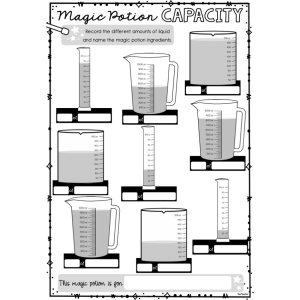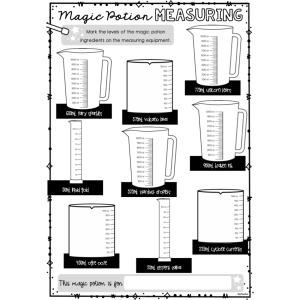Science Capacity Worksheets

Description
Bring a scientific twist to your measurement lessons with these engaging Science Capacity Worksheets. Designed to integrate Science and Mathematics, this hands-on activity will have your students identifying common laboratory equipment while strengthening their skills in reading and recording capacity measurements.
In the first part of the worksheet, students are introduced to illustrations of real-world science equipment such as beakers, measuring cylinders, test tubes, and more. They are asked to label each item using a provided word bank or their own prior knowledge, reinforcing science vocabulary in a practical context. This part of the task supports cross-curricular learning while boosting observation and recall skills.
Following the labelling task, students move on to applying their mathematical understanding of capacity. Each worksheet features measuring equipment with a variety of scales. Students must interpret these scales and accurately record the given capacities by marking the levels on the illustrations. This section encourages students to think critically about volume, scale intervals, and the use of millilitres and litres in different contexts. It also helps develop precision and estimation skills, which are key components of both science investigations and measurement units in mathematics.
Key Learning Outcomes
- ✅ Recognise and name common scientific measuring equipment
- ✅ Accurately read and mark capacity measurements on various scales
- ✅ Distinguish between different units of liquid measurement
- ✅ Strengthen cross-curricular understanding of Science and Maths
What’s Included
- 3 differentiated worksheet versions:
- - Version 1: simplified equipment and basic scale intervals
- - Version 2: includes a wider range of science tools and moderate scale complexity
- - Version 3: most challenging, with varying equipment and scales requiring careful interpretation
- Illustrated measuring equipment for marking and recording capacities
- Word bank and labelling task to support science vocabulary development
Materials Needed
- Printed copies of the chosen worksheet version
- Pencils or fine markers for precision marking
- Optional: real examples of science equipment to enhance engagement and visual connection
How to Use
- Begin the session by reviewing common types of measuring equipment used in science labs and their functions.
- Provide each student with a worksheet appropriate for their level. Use the included word bank or facilitate a group brainstorming session to label the equipment.
- Guide students to carefully examine the measuring scales on each item and mark the correct liquid level as instructed.
- For extension, challenge students to estimate and compare capacities across different containers.
- Review answers as a class or in pairs to encourage discussion about measurement accuracy and equipment use.
Ideas for Classroom Use
- 💡 Use as part of a measurement unit in Maths with a Science focus
- 💡 Include in STEM rotations for an integrated learning experience
- 💡 Combine with a hands-on measuring station using real lab tools and water
- 💡 Assign as a pre-assessment or post-lesson check-in to gauge student understanding
Top Teacher Tips
- 💛 Print worksheets on thick paper and laminate for repeated use with dry-erase markers
- 💛 Scaffold the activity by modelling how to interpret different scale intervals before independent work
- 💛 Encourage students to explain their reasoning for each marked measurement to support deeper understanding
- 💛 Display real science equipment during the lesson to help students make real-world connections
This resource provides a perfect opportunity to blend scientific inquiry with practical mathematics. With its flexible differentiation and real-world application, it is sure to become a classroom favourite for both students and teachers.
Additional information
| Number of Pages | 7 |
|---|---|
| File Format | |
| Australian Curriculum Code | AC9M3M01, AC9M3M02, AC9M4M01, AC9S3I03, AC9S4I03 |
Australian Curriculum V9
F - 6
Lorem ipsum dolor sit amet, consectetur adipiscing elit.
Lorem ipsum dolor sit amet, consectetur adipiscing elit.
Lorem ipsum/ Lorem ipsum/ Lorem ipsum
Lorem ipsum dolor sit amet, consectetur adipiscing elit.
Lorem ipsum dolor sit amet, consectetur adipiscing elit.
Lorem ipsum/ Lorem ipsum/ Lorem ipsum
Lorem ipsum dolor sit amet, consectetur adipiscing elit.
Lorem ipsum dolor sit amet, consectetur adipiscing elit.
Lorem ipsum/ Lorem ipsum/ Lorem ipsum
Lorem ipsum dolor sit amet, consectetur adipiscing elit.
Lorem ipsum dolor sit amet, consectetur adipiscing elit.
Lorem ipsum/ Lorem ipsum/ Lorem ipsum
Lorem ipsum dolor sit amet, consectetur adipiscing elit.
Lorem ipsum dolor sit amet, consectetur adipiscing elit.
Lorem ipsum/ Lorem ipsum/ Lorem ipsum

